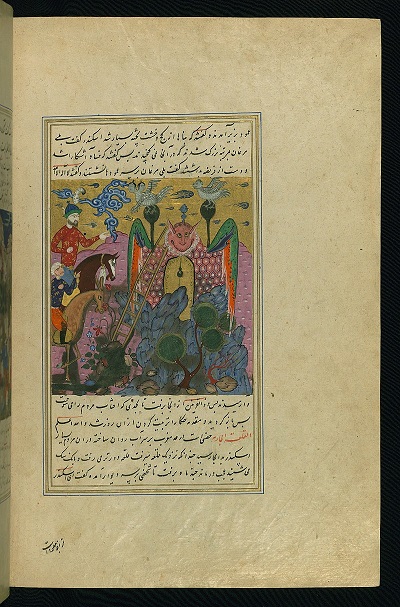
Written by: Mahnoor Faisal Khan
Posted on: February 02, 2023 |  | 中文
| 中文
Alexander the Great's army builds a wall around the people of Gog and Magog
We have a rich legacy of folk tales and fiction pieces acquired from the Middle East. Among these, the constant in our works of fiction, Mount Kaf or Koh-e-Kaf, has upheld its glorified and enigmatic position in our stories. The legend has it that Mount Kaf is the native land of the djinns and was made out of a magnificent emerald. In contrast, Mount Kaf in the Arabic tradition, is a secretive mountain popular as the “farthest point of the earth”, as it is located at the far side of the ocean encircling the earth. The North Pole is sometimes identified with this mountain.
According to Hatim Tai’s interpretation, the Kaf Mountains were said to be composed of green emerald, peridot or chrysolite, whose reflection gave a greenish shade to the sky. It is regarded as inhabited by the Jinns, and the place beyond it is where the celestial world begins. Physical descriptions in stories of Koh-e-Kaf, describe it as having a greenish-blue tint, mirroring the color of the sky and, at the same time, the green on its surface reflecting off to the sky itself. The idea of the Mount ‘encircling’ the Earth could also be explained by the Chinese belief that all the mountains have subterranean veins, connected to one ‘Mega’ mountain, which could be Kaf itself.
In Arabic literature, Kaf was the loftiest of the mountain ranges created by Allah to support the earth, and was the parent of all other earthly mountains, to which it was linked by subterranean ranges. The range is separated from the world of humans by the oceans that surround the known world. Kaf, as the primordial mountain, came to symbolize the cosmic mountain, where the natural and supernatural met and the link between the terrestrial and celestial worlds were established. The emerald-made cities Jabulqa and Jabulsa, situated in darkness, are considered attached to the mountain Kaf.

This folio from the Walters manuscript depicts Alexander the Great meeting with two harpies perched on top of two pillars in the town of Jābalasā
Also, in Iranian mystical literature, Kaf Mountain is a mystical symbol. In some references, it is said that Kaf Peak is the highest point on earth, which is only as tall as a human being from the sky. In ancient times, it was believed that the sun would sink into the well at night behind Mount Kaf, and come out of the well in the morning to brighten the world.
Simorgh’s legend (a benevolent and mythical bird in Persian mythology and literature) says that the precious bird’s nest, is located in the Kaf mountain. And the legendary journey of Simorgh to the top of Kaf mountain has been related to kids in different versions. Mystical sources state that the peak of Kaf is a reference and allusion to the status of kindness. Reaching Kaf means going through the difficult path of life, and reaching the status of humanity and kindness.
It is generally understood by most scholars that Kaf was not always the name for the Mount. It is said to be an Arabic derivation (or rather, borrowing the word itself) from the pre-Zoroastrian scriptures, which call this world-encircling, mythical mountain Alburz. Alburz is said to be a ‘range’ of mountains, all the way from the Arabian lands into the Turkic regions, including present-day mountain ranges like the Hindu Kush, the Caucasus and further spreading out into Syria and North Africa. These Pahlavi (pre-Zoroastrian texts) also affirm that ‘Alburz’ was indeed the center of the world, the birthplace of myths, the land of heroes and an Eden for all. Some scholars attest that perhaps Alexander stayed in the citadel of Derband (front fortress, also known as the Gates of Gates), in the Caucasus, and may have locked Gog and Magog somewhere within the range itself.
Could it be, then, that our search for Mount Kaf finishes right here, within the very peaks of this range? Could it be that all the legends, the hidden Imam, the great bird and Gog and Magog are all based here somewhere? Maybe and then again, maybe not. For now, the mountain remains cloaked in mystery, waiting to eject all her occupants and reveal herself at the End of Times. For now, we let it sleep in peace for years to come.
You may also like: